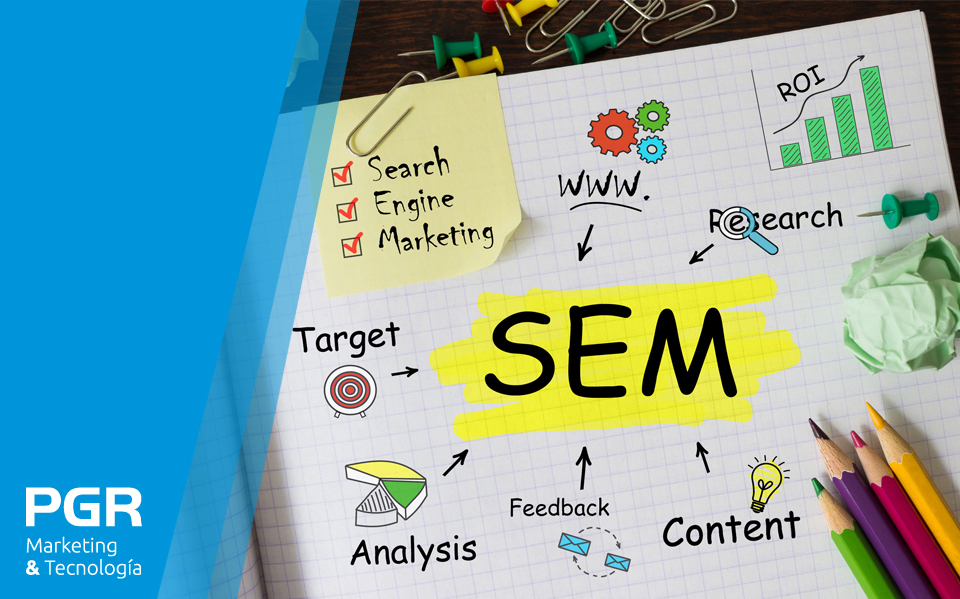The SEM (Search Engine Marketing) is the compendium of strategies to attract traffic to web pages based on the payment for the use of search engines.
By selecting keywords and paying to appear in your searches, we can get users who are looking for those words to click on our link and access our Landing Page.
There are two ways to appear in searches through paid campaigns: Showing an ad (banner) on websites, social networks or applications where there are visitors with a profile that interests us and showing a link in the list of search engine results when they users use the keywords for which we have paid. The first type is known as Display campaigns and the second, Search.
The objective of SEM is to obtain conversions, whether through forms, content downloads, conversations or accessing an offer.
How does SEM work?
SEM campaigns work through an auction system and the algorithms that search engines use to display one or another content.
The key for a campaign to be successful is in the segmentation of the public that we want to attract, since our campaign will be displayed on the web pages, social networks or applications that they visit. If we succeed in selecting the keywords that the users to whom we want to reach our offer will use for their searches, we will have most of the success achieved.
SEM campaigns offer short-term results, although we must bear in mind that the longer the campaigns are active, the better the search engine algorithms will be applied. This happens because search engines learn from all the interactions that users make, and we are not only talking about clicks, downloads and visits, but also if we stop a video before it ends, if we turn up the volume or if we hide an ad…
The cost of SEM campaigns is measured by the number of clicks our ad gets (pay per click) and its performance will depend on the position in which it is displayed and the existing competition for the same keywords.
How is SEM different from SEO?
SEO (Search Engine Optimization) are strategies for optimizing our content to appear organically in search engine results, that is, for free. Instead, SEM strategies are paid.
To appear organically in the first positions of the search results, we must use the creation of quality and relevant content for our target audience, such as blog posts, web pages, posts on social networks, etc. On the other hand, for SEM we must design timely, well-targeted ads that include some powerful call to action.
Create a good SEM campaign in 6 steps
1. Segmentation
The better you know your target audience, the easier it will be for you to design an effective campaign that offers exactly what your ideal customer is looking for. In the segmentation you must take into account their interests, the web pages they visit, the content they consume, what social networks they use and where they shop. This information will help you better choose the keywords to bet on.
2. Choice of Keywords
Search for the most relevant keywords and update them as many times as necessary. This is an ongoing process: study their performance and change them if they are no longer relevant. For this, you can use the scheduler offered by Google.
3. Don't forget SEO
Your payment strategy should not be the only one you use. In fact, SEO and SEM are strategies that feed back. Getting a click on an attractive ad will be of no use if the page where that click takes you does not meet expectations in terms of usability, relevance, and user interest.
Do not neglect the articles of your blog, nor the name of the URL, nor the links or multimedia content.
4. Include Landing Pages
Although it is not essential, including a good landing page can help you convert a click into a pretext for a potential client to leave you their data and unequivocal signs of their interest in your offer.
A good landing page, unlike another page on your website, must be free of content that distracts you from your specific objective and your specific offer.
5. Conduct A/B tests
It is advisable to start the same campaign with two different designs to see how it behaves, and decant and adjust the ads and keywords to what gives better results. Try different CTA's, different sizes and styles, etc.
6. Follow up
One of the advantages of Internet advertising is the ability it gives us to make adjustments and changes during the development of the campaigns, without having to wait until the end.
Since the cost of the campaign not only depends on the number of clicks it generates but also on the quality of the interactions it causes, monitoring its performance and whether it meets the objectives is very important.
The Internet offers many possibilities in terms of advertising, and we should take advantage of them as much as we can. This is not always easy, because different needs and fields of knowledge are mixed. SEM is a good example of this, since it requires knowledge about the study of our potential market, algorithms, and Machine Learning.
At PGR, we can help you guide your campaigns in search engines and turn SEM into one of your most valuable strategies to generate business.





